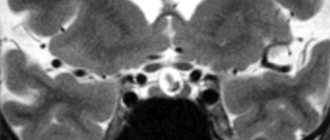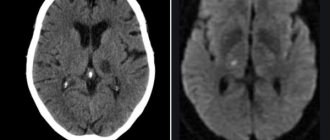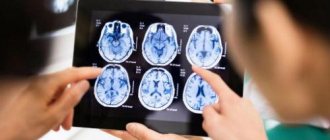This category includes mixed conditions that are causally related to brain disorders due to a primary brain disease, a systemic disease secondary to the brain, exposure to exogenous toxic substances or hormones, endocrine disorders, or other physical diseases.
Excluded: related to:
- delirium (F05.-)
- dementia classified under F00-F03
due to the use of alcohol and other psychoactive substances (F10-F19)
Diagnosis F 06.0 Organic hallucinosis
A disorder characterized by persistent or recurrent hallucinations, usually visual or auditory, that occur during clear consciousness and may not always be recognized as such by the patient. A delusional interpretation of hallucinations may be noted, but delusions do not dominate the clinical picture; awareness of the surroundings can be maintained.
Organic hallucinatory state (non-alcoholic)
Excluded:
- alcoholic hallucinosis (F10.5)
- schizophrenia (F20.-)
Diagnosis F 06.2 Organic delusional [schizophrenia-like] disorder
A disorder in which the clinical picture is dominated by persistent or recurrent delusions. Delusions may be accompanied by hallucinations. There may be some symptoms that make you think you have schizophrenia, such as bizarre hallucinations or disordered thinking.
Paranoid and paranoid-hallucinatory organic states
Schizophrenia-like psychosis in epilepsy
Excluded: disorder:
- acute or transient psychotic (F23.-)
- persistent delusional (F22.-)
- drug-induced psychotic (F11-F19 with common fourth character .5)
schizophrenia (F20.-)
One of the most common reasons for parents of preschool children to visit a doctor is their pronounced emotional lability. Children with this pathology are characterized by constant tearfulness, moodiness, and affective excitability. At different times, to define the condition of such children, terms such as “neuropathy”, “early childhood nervousness”, “neuropathic constitution”, “syndrome of autonomic-visceral disorders”, “increased neuro-reflex excitability”, etc. were used.
In accordance with ICD-10 (section F.06.6), such conditions are defined as organic emotionally labile (asthenic) disorder (OELD).
The term “neuropathy” was introduced in 1915 by E. Kraepelin to designate nonspecific hereditary disorders, characteristic primarily of infancy.
The term “neuropathy” in domestic psychoneurology refers to a syndrome of increased excitability of the nervous system and immaturity of autonomic regulation. Increased nervous sensitivity in such children manifests itself in the form of a tendency to display affect, emotional disorders and anxiety. The occurrence of this pathology is explained by exogenous influences in the prenatal period [8]. According to a number of authors [4, 7], the basis of neuropathy is a functional failure of autonomic regulation, which is also determined in neuroses [10].
T.P. Simson [13] proposed that early childhood neuropathy represents a form of functional mental disorder. She identified exogenous neuropathy. Among exogenous causes, she mentioned acute childhood infections, tuberculosis, syphilis, hearing loss, and physical trauma. Later G.E. Sukharev [14], as well as S.S. Mnukhin [12] showed that in the origin of neuropathic conditions, not so much constitutional-genetic factors play a role as exogenous-organic factors acting in the perinatal and early postnatal periods. Yu.A. Yakunin and E.I. Yampolskaya [16] showed the role of autonomic-visceral dysfunctions in the genesis of this pathology.
V.V. Kovalev [9] in his textbook identified 3 main types of neuropathy: true, or constitutional, organic and mixed type. G.E. Sukhareva [14] additionally distinguished asthenic and excitable variants of neuropathy. At the same time, many authors emphasized that none of the forms of neuropathies is accompanied by intellectual decline.
In foreign psychiatry, since the 80s of the last century, when describing the pathology in question, the term “oppositional defiant disorder” - ODD (English oppositional defiant disorder - ODD; according to ICD-10 heading F.91.3) is used. We are talking about children whose behavior is characterized by outbursts of anger, bickering, and defiant behavior.
Estimates of the prevalence of ODD in the population vary from 2 to 16% [18]. During preschool age, ODD is more common in boys than girls, but during adolescence this ratio reverses.
Children with this disorder tend to frequently and actively ignore rules or requests from adults and deliberately harass other people. They are usually angry, touchy, and easily annoyed by other people, whom they blame for their own mistakes and difficulties. They usually have low levels of frustration tolerance and mild loss of self-control. In typical cases, the defiant behavior of such children is of a provocative nature, so that they become the instigators of quarrels and usually show excessive rudeness, reluctance to interact and resistance. Children with ODD exhibit age-inappropriate stubbornness and irritability. This type of conduct disorder is more common in children younger than 9 to 10 years of age and is defined by the presence of markedly defiant, unruly behavior and the absence of more severe dissocial or aggressive behavior that violates the law or the rights of others. At an older age, a transition from ODD to behavioral disorder characterized by aggression, fighting, and theft is possible [17, 19, 21].
In clinical practice, gamma-aminobutyric acid (GABA) preparations are most often used to treat OEPR: pantogam, phenibut, picamilon, as well as sedatives, often of plant origin.
The purpose of this study is to study the clinical and psychopathological manifestations of OERD and evaluate the effectiveness of treatment of children with this pathology using the drug adaptol.
Material and methods
60 children aged 5-7 years (average - 6.1±1.7 years) were examined. The parents of these children complained about their emotional lability and capriciousness.
The diagnosis was made on the basis of ICD-10 criteria, according to which the patient’s condition could be assessed as OEPD (category F.06.6).
The examination of the neurological status was carried out according to the generally accepted scheme.
The psychological examination included determination of the anxiety level index using the test by R. Temple et al. The severity of behavioral disorders was assessed using the SNAP-IV scale. This scale is intended primarily to assess the severity of clinical manifestations of attention deficit hyperactivity disorder (ADHD), but items 32-40 reflect manifestations of ODD. Based on the parents' responses, indices of impulsivity and ODD were also calculated. In addition, a technique for assessing fine motor skills was used (Lesny test for dyspraxia-dysgnosis) [11]. The state of the autonomic nervous system was assessed using a questionnaire by A.M. Veina. To objectify the severity of asthenic disorders, parents assessed the degree of fatigue of the child using a visual analogue scale (VAS, 10-point version). The neuropsychological study also included the Ozeretsky test for reciprocal hand coordination and the “Finger Counting” test. The degree of attention impairment was determined using the TOVA continuous activity test (Test of Variables of Attention), which allows assessing the state of attention and the level of impulsivity in relation to normative data for each age. The test is based on presenting to the subject in random order significant (requiring a response) and insignificant (not requiring a response) stimuli that appear on the computer screen in the form of geometric shapes. The results of the study made it possible to quantify the degree of inattention (errors in missing significant stimuli), the level of impulsivity (errors in responding to insignificant stimuli), the speed of information processing (response time) and the stability of responses (response time dispersion).
EEG recording was carried out using 19 electrodes located on the surface of the head in accordance with the international 10-20 system, at rest with eyes closed and open (3 minutes each). To control eye movements, an electrooculogram (EOG) was recorded. Absolute EEG power was calculated and compared between groups of subjects in the θ- (4-7 Hz), α1- (7-12 Hz), β1-(14-20 Hz), β2- (20-30 Hz) ranges.
During the open controlled study, patients were divided into 2 groups. The drug adaptol was used to treat patients in the main group (30 patients). Patients received adaptol for 30 days at a daily dose of 500 mg, divided into 2 doses (250 mg each). In the comparison group, consisting of 30 children with similar clinical and neurophysiological parameters, treatment was carried out with Pantogam [15], at an age-specific dose of 0.75 g per day for 1 month. The control group consisted of 60 practically healthy children of the same age.
results
All 60 children from the treatment groups showed increased fatigue and exhaustion. The average level of children's fatigue assessed by parents was significantly higher than in the control group (Table 1).
| Table 1 |
The results of the studies showed an increased level of anxiety in children from the treatment groups compared to the control (see Table 1).
Scores on the SNAP-IV scale (especially impulsivity and indicators reflecting manifestations of ODD) also turned out to be significantly higher in the treatment groups. Most parents noted that their children's mood very often drops. In 47 (78.3%) cases, children were often irritable. In 36 (60.0%) cases, children's behavior was characterized by frequent arguments with adults, ignoring their comments, and refusal to comply with demands.
In 46 (76.7%) cases, children with OELD had sleep disturbances. Most often these were difficulties falling asleep.
When studying the neurological status of children in the study groups, it was not possible to detect pronounced focal symptoms, but in children with OELD in 32 (53.3%) cases the following symptoms were detected: moderate diffuse decrease in muscle tone, revival of deep reflexes, expansion of reflexogenic zones, anisoreflexia, lungs violations of the coordination sphere, mainly in the form of dysdiadochokinesis, and elements of cerebellar ataxia. In the control group, scattered microfocal symptoms were detected only in 6 (10.0%) children. A study conducted using the Lesna test showed the presence of moderate dyspraxia in 37 (61.7%) patients from the observed group. The average score was 21.5±4.2 (with the norm being 26 points or more), which indicated manifestations of dyspraxia.
Manifestations of autonomic dysfunction (marbling, pallor of the skin, diffuse or local hyperhidrosis, meteosensitivity, etc.) were observed in 46 (76.7%) children in the study group, and in 13 (21.6%) cases in the control group. The results of comparison of data from a study of the functions of the autonomic nervous system showed significant differences: the average score in children with OELD was significantly higher than in children from the control group (see Table 1).
When performing the Ozeretsky test, difficulties in the form of synkinesis were identified in 38 (63.3%) patients with OELD and in 9 (15.0%) children from the control group. The average score for this test in children with OELD was 4.6±0.8, in the control group - 6.3±1.4 (p<0.05).
When testing the “finger counting” test in patients with OELD, in 52 (86.7%) cases, difficulties were noted in the form of missing fingers and disturbances in the order of movements, as well as multiple synkinesis. In the control group, such disorders were detected in 11 (18.3%) cases. The average score for this test in children with OELD was 42.5±1.76; in children from the control group - 33.4±1.4, thus children with OELD performed this test significantly worse (p<0.05).
According to the electroencephalographic study with eyes closed in the α- and θ-ranges, statistically significant differences were obtained between the study groups (p <0.05). In patients with OELD, there was a decrease in the power spectrum of α-band waves; these differences were maximum in the occipital-parietal leads of both hemispheres. In patients with OELD, compared to healthy subjects, the power of the θ rhythm was significantly higher (p <0.05). These differences were observed in all leads.
The psychophysiological study TOVA showed that children with OELD showed a significant increase in impulsivity and a slight increase in inattention compared to children from the control group. There were no significant differences in the response rate (Table 2).
| Table 2 |
| ]]> |
After treatment with adaptol, an improvement in clinical symptoms was observed in 19 (63.3%) children of the main treatment group. After treatment, parents noted that their children became less tired. The average fatigue score of children from the main group, assessed by parents after treatment, was 3.5 points, which indicates a significant improvement.
Significant positive changes have also occurred in the behavior of patients: manifestations of impulsiveness and aggressiveness have decreased, relationships with peers have improved in situations in which conflicts often arose previously. Changes in behavior are reflected in table. 1. It should be noted that after the course of adaptol there was a sharp decrease in irritability. In addition, the process of falling asleep improved after treatment. There was also a significant improvement in vegetative status with a decrease in the average score on the A.M. questionnaire. Wayne [3].
Upon repeated psychological examination, a pronounced decrease in the anxiety index in children was noted (see Table 1). No significant changes were found in other neuropsychological tests.
According to a repeated EEG study, in the group of children taking adaptol, there was a significant increase in α-activity in the occipital-parietal leads of both hemispheres, a decrease in wave power in the α-range over almost the entire convexital surface (p<0.05).
A repeated psychophysiological study after treatment with adaptol revealed a statistically significant decrease in impulsivity (see Table 2). There were no significant changes in inattention scores or reaction time.
A side effect in the form of transient drowsiness was noted in 2 (6.7%) children. No other side effects were identified.
When treated with Pantogam, an improvement in the clinical condition of 14 (46.7%) children with OELD was also observed. After treatment, parents noted that their children became less tired. The average indicator of children's fatigue assessed by parents after treatment in this group was 4.7 points, which indicates a significant improvement. Changes in behavior are reflected in table. 2. There were no significant dynamics of autonomic symptoms. Moreover, in 11 (36.7%) cases there was a worsening of the clinical picture in the form of hyperexcitability and increased difficulty falling asleep.
During the repeated psychological examination after treatment with Pantogam, no significant decrease in the anxiety index was noted (see Table 1). Repeated neuropsychological and psychophysiological studies in this group also showed no significant changes.
Discussion
The leading, underlying OELR syndrome is asthenic. Many authors [1, 2, 9, 14, 20] regard asthenia as an “axial” syndrome of residual organic cerebral pathology in children. It can be assumed that residual asthenia is the basis to which other symptom complexes are added. Thus, the study showed that children with OELD, in addition to asthenic disorders, are also characterized by an increased level of anxiety and irritability.
The identified neurological symptoms may reflect disruptions in connections between areas of the frontal cortex, basal ganglia and cerebellum.
In addition, signs of psychovegetative pathology in children with OELD should be noted. According to D.N. Isaev [6], changes in brain activity contribute to the accumulation of affective tension (anxiety) and tension in autonomic activity.
The results of an electroencephalographic study may reflect a delay in the maturation of nonspecific regulatory systems of the brain in children with OELD.
The study showed that adaptol is a highly effective treatment for OERD in children. The results of its use in most respects exceed the results of using the traditionally used drug Pantogam. While taking adaptol, anxiety and irritability decrease and behavior improves. In addition, there is an improvement in vegetative status. The results of a repeated electroencephalographic study after treatment with adaptol show a decrease in signs of functional immaturity of the brain.
It is also important that the use of adaptol is almost not accompanied by unwanted side effects and complications. The spectrum of action of the drug is determined by a combination of activating and inhibitory effects, which are based on the influence of the drug on serotonergic, GABAergic and dopaminergic mechanisms [5]. The clinical effect is confirmed by the results of psychophysiological studies indicating a decrease in impulsivity, in the absence of an inhibitory effect.
The data obtained led to the conclusion that adaptol is an effective treatment for OERD in children.
Diagnosis F 06.7 Mild cognitive impairment
A disorder characterized by decreased memory, difficulty learning, and decreased ability to concentrate on a task for long periods of time. There is often a pronounced feeling of mental fatigue when trying to solve a mental problem; learning new things seems subjectively difficult, even when objectively it is successful. None of these symptoms are severe enough to warrant a diagnosis of dementia (F00-F03) or delirium (F05.-). This diagnosis should be made only in connection with a specified physical disorder and should not be based solely on the presence of any mental or behavioral disorders classified in categories F10-F99. The disorder may precede, accompany, or follow a wide range of infectious and somatic diseases (both cerebral and systemic), but there does not necessarily need to be direct evidence of brain involvement. This disorder can be differentiated from post-encephalitic syndrome (F07.1) and post-concussion syndrome (F07.2) by its different etiology, more limited range of mostly mild symptoms and usually short duration.
Psychoorganic syndrome
Organic mental disorders are characterized by the mandatory presence of the so-called. psychoorganic syndrome (impaired emotions, memory and intelligence). The mood may be inappropriately increased or decreased, anxiety or a sad-angry mood may be observed. Affect (emotional manifestations) is characterized by lability (variability), explosiveness (explosiveness), flattening (insufficient depth of experience). All memory processes (memorization, storage, reproduction of information) are reduced. False memories are observed (confabulations), memory for some periods of life is completely absent (amnesia). Thinking is characterized, on the one hand, by inhibition of mental processes (torpidity), difficulty switching (rigidity), and on the other hand, by increased exhaustion. The general level of thinking decreases (concepts and ideas become impoverished), a tendency to unnecessary detail appears, and perseverations arise (“getting stuck” and constant repetition of the same thought or expression). The ability to navigate is impaired - first in the environment, and then in one’s own personality. The ability to grasp the full meaning of a situation disappears; only partial details are perceived.









